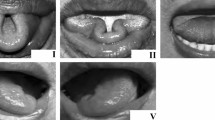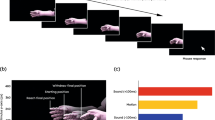Abstract
In five subjects, head movement during conversation was monitored by polarised light goniometry, and recorded alongside speech and a signal proportional to peak amplitude of sound waves (‘peak loudness’). Kinematic properties of listeners' head movements, such as amplitude, frequency and cyclicity, differentiated various conversational functions. That is, they were function-specific: symmetrical, cyclic movements were employed to signal ‘yes’, ‘no’ or equivalents; linear, wide movements anticipated claims for speaking; narrow linear movements occurred in phase with stressed syllables in the other's speech (‘ynchrony’ movements); and wide, linear movements occurred during pauses in the other's speech. That, it is argued, bears upon the relation between thesignalling of communicative intentions and the synchronisation of interactional rhythm. Thus, the former appears to determine the timing and tempo of responses such as ‘yes’ and ‘no’, while the latter determines the regulation of ‘synchrony’ movements. The manner in which these factors interact in other conversational functions and their theoretical implications are discussed.
Similar content being viewed by others
References
Beattie, G.W. Sequential temporal patterns of speech and gaze in dialogue.Semiotica 1978,23 29–52.
Birdwhistell, R.L. Sequence and tempo. In: R.L. Birdwhistell,Kinesics and Context. Philadelphia: University of Pennsylvania Press, pp 158–162, 1970.
Chapple, E.D.Culture and Biological Man. New York: Holt, Riuehart and Winston, 1970.
Condon, W.S., Ogston, W.D. A segmentation of behaviour.Journal of Psychiatric Research 1967,5 221–235.
Duncan, S. Jr. Some signals and rules for speaking turns in conversation.Journal of Personality and Social Psychology 1972,23 283–292.
Duncan, S. Jr., Fiske, D.W.Face-to-Face Interaction: Research, Methods and Theory. Hillsdale (NJ): Erlbaum, 1977.
Exline, R.V. Visual interaction: the glance of power and preference. In: J.K. Cole (ed).Nebraska Symposium on Motivation. Lincoln: Nebraska University Press, 1972.
Gibson, J.J.The Ecological Approach to Visual Perception. Boston: Houghton Mifflin, 1979.
Hadar, U., Steiner, T.J., Grant, E.C., Clifford Rose, F. Kinematics of head movement accompanying speech during conversation.Human Movement Sciences 1983a,2 35–46.
Hadar, U., Steiner, T.J., Grant, E.C., Clifford Rose, F. Head movement correlates of juncture and stress at sentence level.Language and Speech 1983b,26 117–129.
Hadar, U., Steiner, T.J., Grant, E.C., Clifford Rose, F. The timing of shifts of head postures during conversation.Human Movement Science 1984a,3 237–245.
Hadar, U., Steiner, T.J., Clifford Rose, F. The relationships between head movement and speech dysfluencies.Language and Speech 1984b,27 333–342.
Jakobson, R. Motor signs for ‘yes’ and ‘no’.Language in Society 1972,1 91–96.
Kendon, A. Movement coordination in social interaction: some examples described.Acta Psycholigica 1970,32 100–125.
Kendon, A. Introduction. In A. Kendon (ed),Nonverbal Communication, Interaction and Gesture. The Hague: Mouton, pp 1–53, 1981.
Kinsbourne, M. Eye and head turning indicates cerebral lateralisation.Science 1972,176 539–541.
LaBarre, W. The cultural basis of emotions and gestures.Journal of Personality 1947,16 49–68.
Mitchelson, D.L. Recording of movement without photography. In D.W. Grieve, D.I. Miller, D.L. Mitchelson, J.P. Paul and A.J. Smith (eds.),Techniques for the Analysis of Human Movement. London: Lepus Books, pp 33–69, 1975.
Rosenfeld, H.M. Conversational control functions of non-verbal behaviour. In: A.W. Siegman and S. Feldstein (eds).Non-verbal Behaviour and Communication Hillsdale (NJ): Lawrence Erlbaum, pp 291–338, 1978.
Rosenfeld, H.M. & Hancks, M. The nonverbal context of verbal listener responses. In M.R. Key (ed.),The Relationship of verbal and Nonverbal Communication. Mouton: The Hague, pp 193–206, 1980.
Scheflen, A.E. The significance of posture in communicative systems.Psychiatry 1964,27 316–333.
Shaffer, L.H. Rhythm and timing in skill.Psychological Review 1982,89 109–122.
Sokal, R.R. & Rohlf, F.J.Biometry: The Principles and Practice of Statistics in Biological Research. San Francisco: Freeman, 1981.
Vavra, V. Is Jakobson right?Semiotica 1976,17 95–110.
Author information
Authors and Affiliations
Rights and permissions
About this article
Cite this article
Hadar, U., Steiner, T.J. & Clifford Rose, F. Head movement during listening turns in conversation. J Nonverbal Behav 9, 214–228 (1985). https://doi.org/10.1007/BF00986881
Issue Date:
DOI: https://doi.org/10.1007/BF00986881




